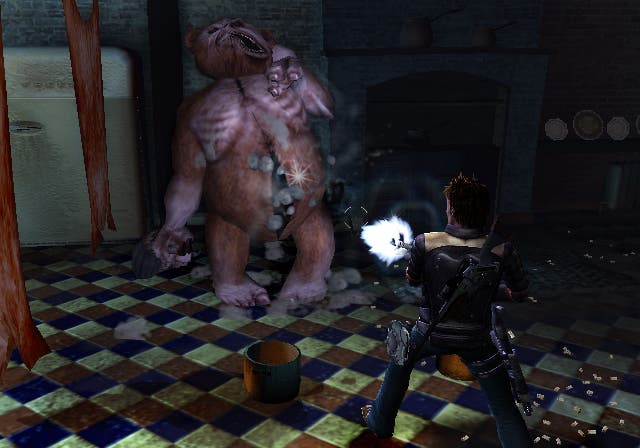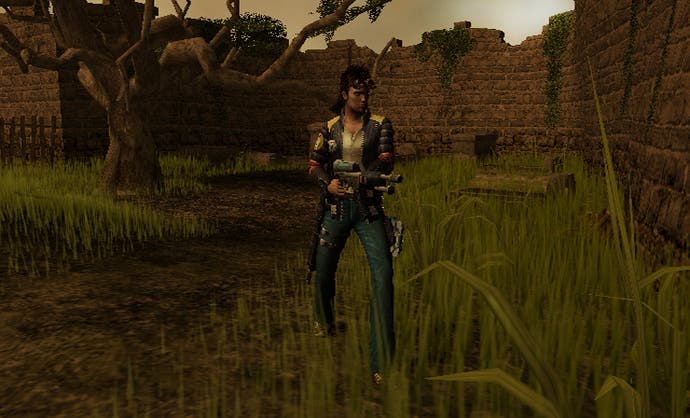Ghosthunter
Sony's Cambridge studio invites you to embrace the dead.
Sony's Studio Cambridge may still be licking its wounds after Primal suffered a mauling in the press, having seemingly got caught up in its own hype thanks to a procession of artsy marketing ideas and folks dressed up as gargoyles on Oxford Street - none of which stopped it from tanking at retail and being reduced to £20 almost from day one - but the BAFTA award-winning MediEvil developer has obviously found a stash of industrial elastoplast, because it's already on the rebound with Ghosthunter, a sort of Se7en meets Ghostbusters tale of malformed monstrosities, the macabre and a wisecracking cop on a quest to put a spectral uprising back to bed.
Primal Scream

Although Ghosthunter shares certain elements with its forerunner - a sort of buddy system for progression (although this time the ghostly sidekick is a beautiful woman who can float around and help overcome common problems) and plenty of otherworldly adversaries - it's more of an ethereal shoot-'em-up, with main character Lazarus Jones softening up the undead with his plasma-style rifle and then snagging them with a Ghostbusters-style box that actually works like a boomerang, smacking enemies and capturing them before returning to his hand - with a beautiful spherical rippling effect as they're hauled away to the sound of their own anguished cries.
Judging by the introductory movie and larger-than-life (or death) source of evil exposed early on, in terms of story it seems like another gothic epic. Somewhere in the past (we know it's the past because there are skeletons in suits of armour and nobody bothers to pick up decapitated heads on the battlefield), a cloaked figure infiltrates a massive castle and attacks a nasty, scar-faced Legacy Of Kain reject who seems to have kidnapped a young girl. As it concludes, the cloaked Ghosthunter - complete with abovementioned plasma rifle-alike - is running headlong into a face-off with scarface.
Fast forward to the present day and we meet Lazarus Jones, a Detroit cop with all the trimmings - loose tie, short-sleeve shirt, Brad Pitt haircut [which one? - he's got billions -Ed], chiselled jaw, rugged good looks and gun firmly in hand - and his highly strung female partner, out on a call to an abandoned school that once played host to a series of mysterious murders. As she investigates the upper floors, Jones descends to the basement, wading convincingly through effluent green sewage on his way into an odd-looking room where he encounters an array of dials and containers stacked behind a big red button. Which he obviously pushes.
Uh-oh

At which point all hell quite literally breaks loose, with wispy demonic heads soaring through the pipes and rafters and escaping through the manholes (apparently these chaps can't make it through solid walls), and even into him. Having located and turned on the backup power system for the apparently mechanical holding system he accidentally unlocked (and, in fairness to him, demon hunters should label their sodding buttons), Jones spends the next few minutes whiting out (complete with photonegative visual effect), being introduced to the tools and methods of a Ghosthunter (plasma rifle and Ghostbusters-style collection boomerang included) and seeing his partner snapped up by the scarred bully from the opening cinematic - who apparently thinks she unlocked him and who wants to consume her flesh. Lovely.
Ghosthunter manages to keep the tutoring gratifyingly brief. A confused Jones, fed up of the ambiguous musings of his training computer, threatens to shoot it on the count of five - leaving the patient entity with barely enough time to explain the mechanics of movement (left stick), camera control (right stick), context-sensitive moves (open door, MGS-style wall hug, Tomb Raider-style climbing, object pick-up, etc, mapped to X), third and first-person targeting (circle to switch between exploration-minded 'run' mode and reticule-based targeting, triangle to switch to a more accurate, almost TimeSplitters-esque first-person view) and weapon usage (R1 to target and fire, R2 to throw the ghost-catching grenade).
Obviously it all comes fluently to anybody with much third-person experience, and it has to, because no sooner has Jones struck five and raised his gun than a monstrous brown horror gurgles and smashes through a nearby wall, showering the room in brick dust and coming straight for Jones. Pumping the ghostly plasma rifle whatsit for all it's worth, Jones manages to halt the demon long enough to chuck the fetcher grenade, which promptly swallows the nasty in one ethereal gulp. Tooled up and ready to face the demons, Jones soldiers on, with only one question really bouncing around our heads - how come he can see these spectral spoilers when his sharp-tongued counterpart can only see scarface when he grabs her by the arms?
An out-of-body experience

All is revealed soon after as Jones finds his way into a smashed up Gents on the first floor, home to several battered cubicles and a big glowing portal-like circle on the floor. Through a speaker on the wall, Jones' mechanical mentor tells him that during the mass ghost breakout, one particular ghost fused herself with him, handing him the gift of second sight - or the ability to see apparitions whether they take physical form or not - and this circle is used to extract her for certain sections, allowing her to float around and investigate, and make use of several abilities to help Jones through any difficulties ahead. Perhaps setting us up for some teamwork-based puzzles, it turns out that the seductive floating nightgown Astral's first significant ability is to take on physical form, allowing her to operate switches and perform other tasks.
However, although she can float around almost indefinitely (and return instantly to Jones with a stab of the circle button), using her abilities absorbs ghost power from Jones, and the only way to gather ghost power is - you've guessed it - to suck up ghosts using the grenade boomerang toy. Just as well then as the muted Astral quickly returns to Jones' body to show him another monstrous brown stomper smashing his way through the doorway.
As we left it, Ghosthunter was really starting to take on promise. Although we can see ourselves tiring of Jones' constant wisecracking and complaining (not to mention the Bryll Cream advert on top of his head), and there are some camera issues to round off in our preview code (navigating as Astral is also a bit cumbersome, as she can move around like a normal third-person character but to hover or descend she has to use R1 and R2, somewhat oddly), it's a game with potential, and it stands a better chance of reeling us in than Primal's rather overblown premise.
Resident Hill or Silent Evil?

Although some might liken it to survival horror titles Resident Evil and particularly Silent Hill, Ghosthunter really doesn't have a huge amount in common with those titles in terms of actual play mechanics. Resident Evil is a far more cinematic and slow-paced game, obsessed with brooding music, sharp pangs and menacing shadows, long-winded puzzle-solving and exploration - and enemies that stand a good chance of taking a vital chunk out of your neck if you try to kill them all. Ghosthunter meanwhile is more of an action-adventure, with a character shoehorned around a fairly open environment which is nevertheless cordoned off depending on the direction the game intends you to go, and less of an 'us against them' dynamic given that Jones is sharing his life force with a ghostly companion anyway. Obviously the linear design means plenty more locked doors that will never open, which can be particularly frustrating if you lose sight of the one you are meant to open, especially as many of them are seemingly just taped up, but the emphasis in Ghosthunter is more on taking down ghosts, with more and softer enemies than in either RE or Silent Hill, and more arcadey combat that doesn't bother itself too greatly with ammo conservation. As for puzzles, we've yet to be truly puzzled by it.
The comparisons to Silent Hill are probably more justifiable; although again it's not as dark and scary, with very few moments in the code we've seen where the developer hides round the corner and screams "Boo!" as you pass. Indeed, Studio Cambridge seems happier to shove horror right down your throat - or have it come pouring out, as seen in one particularly well-documented section when a sobbing lady coughs up and is consumed by a demon. Graphically it's far more SH than RE, with grimy, rundown environments full of mucky texturing and several monsters that could have crawled straight out of Konami's most recent adventure, but in terms of character models we're swinging back toward the Capcom stable again, with thoroughly detailed facial expressions and some possibly ground-breakingly good lip-synching. Either way, we're expecting the developer to get to grips with the threat of horrors in the dark soon, having given us a rather fetching torch strapped to the end of the rifle.
However it would be churlish to discuss the game's visual look without paying tribute to some of Studio Cambridge's camerawork and, of course, Jones' spectral adversaries. The game so far has been alive with neat directorial flourishes - cameras that flop wonkily around for dramatic effect, forcing you to wrestle harder with the controls during moments of uncertainty, not to mention the white out effects, which couple superbly with the atmospheric screams and moans that threaten at every turn. The ghosts are stars too, right from the get go as a playful poltergeist zooms around the menu screens behind all the buttons, occasionally flying up close to tap on the inside of the screen, and thanks to those throbbing, spherical implosions their death sequences are hugely gratifying.
The Haunted
Although we're understandably cautious about this one after Primal wrote plenty of cheques it couldn't cash, and we have some concerns about the feel of the game and the way Jones is controlled in our preview build, Ghosthunter is a surprisingly affable affair that beckons the gamer with an intriguing combination of ideas. The combat is quite engaging, the Jones/Astral relationship has the potential to throw up some interesting scenarios, and there's even scope to inject some Ghostbusters-esque humour, as long as Jones can get over his arrogant "what the hell is going on?" dialogue. Assuming Studio Cambridge hasn't been sitting around since they burnt off this preview code, with polish Ghosthunter could mark a return to form for the developer come November 28th.

